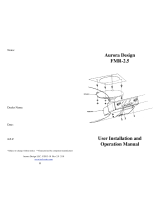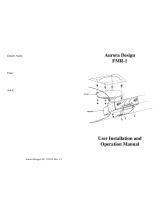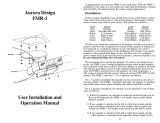Page is loading ...

Release Date
January 2014
1968 #673101B & 1969 #683101B
MOPAR
®
'B' Body
AM/FM STEREO
RADIO INSTALLATION
AND
OPERATING INSTRUCTIONS
AM/FM9.2
Dodge
Charger
Coronet
Super Bee
Plymouth
Belvedere
GTX
Roadrunner
Satellite
Add our Bluetooth® adapter kit option! Answer
incoming calls and place outgoing calls with compatible
phones — all without having to fumble around for your cell
phone. You can also stream music from any compatible
phone or tablet — use the dedicated keys to skip or replay
tunes. Built in USB 2.1 Amp charger. NFC simple pairing
function.
ANTIQUE AUTOMOBILE RADIO, INC.
700 TAMPA RD. Palm Harbor, FL 34683 USA (727) 785-8733
For HELP, Questions or Comments email:

CONGRATULATIONS! You have one of the most unique and sophisticated radios ever built! It is designed for a long trouble free life
and quality sound. Our objective is to preserve the original fit, functions and appearance of your radio while providing superior sound
using the best of the latest digital technology. The more modern features that were not available when your vehicle was new are cleverly
disguised so that they are functional and easily accessible, but are not visible. The face, thumbwheels and pushbuttons are designed to
look and feel just like the original. Please take a few minutes to read this manual and familiarize yourself with all of the features of this
radio. Note: The dial pointer and pushbuttons are electrically operated and will not function without power.
Although this radio is considerably smaller than the original, it will fit in the dash without any alterations. The radio is designed to work
well with the original antenna. Do not use the original speakers. They will not handle the power or the frequency range of this radio.
Before you begin installation: Be Safe! Disconnect one battery terminal and leave it disconnected until installation is complete. Make
sure you are familiar with the options and features programmed into this radio. Locate the antenna jack, the auxiliary input, line outputs
and other options you may need before you mount the radio. If you want to “bench test” the radio use a fully charged battery. DO NOT
operate this radio directly from a battery charger. Serious damage may result!
This radio is built for 12 volt negative ground systems only! The radio has several protection circuits to help prevent serious damage from
wiring errors and power faults in the vehicle electrical system. Never use a fuse rated for more than 10 Amps!
A major consideration will be speakers. There are many possibilities for additional speaker placements. You will have to decide what will
work best for your application. Will it matter if the speakers show? You might consider kick panel, door speakers, or mounting speakers
under the dash where they’re out of sight. You can add an external amp or sub woofer (see next page).
Use one 4 ohm speaker for each channel you want to connect. Make sure it can handle the wattage! Unless you crank it all the way up
regularly, 30 or 40 watt RMS ratings should be sufficient. The higher the SPL rating of the speaker, the better it sounds. Look for an SPL
of 88 or better. A good full range speaker should have a frequency range from less than 40 Hz to better than 20 kHz. Pay attention to
polarity! Speaker terminals will be marked with a + and - , or a red dot on the + terminal. If all speakers are connected to the proper
polarity, they will operate in harmony. If they are not properly phased, you will not hear the full fidelity of the radio. Note: - does not
mean ground! This is a high power radio in which both speaker lines are driven with high currents! Never allow any speaker lead to
become grounded when the radio is on!
Operating Your Radio
Refer to the picture on the front page for control locations. Your new radio has the same type of controls in the same positions as the
original radio. Because the original was a “Mono” radio, there is no visible stereo indicator or balance control. To turn the radio ON, roll
the leftmost thumbwheel up. Continuing to roll the thumbwheel up will increase volume. Rolling the thumbwheel down will decrease
volume until the radio clicks off.
Tuning: The tuning thumbwheel is next to the ON/OFF/Volume control. Rolling the thumbwheel up will move the dial pointer up the dial
scale. Rolling the thumbwheel down will move the dial pointer down the dial scale. There is no stop on this thumbwheel. The dial pointer
will stop moving when it reaches the top or bottom of the scale. Note: The dial pointer will only move when the radio is powered on.
Setting pushbuttons: Your radio has 5 presets for FM, and 5 for AM. A major difference between the original radio and this one is the
way the pushbuttons are set. Never attempt to pull out on the buttons! When you push a button, the radio will start playing the selected
station, and the dial pointer will move to the selected location. To set a button to a different station: (1) Tune in the desired station. (2)
Press and hold the button you want to set. The tuner will move to the previous setting. (3) After about 2 seconds, the radio will begin
playing the newly selected station. The dial pointer may cycle a few times to locate the correct position. This is a normal procedure. The
dial pointer will stop at the new station. (4) Release the button. Be aware it takes a couple of seconds to write the new pushbutton data to
permanent memory. You can continue to set other buttons or tune other stations, but if the radio is turned off before the write cycle is
completed, the new stations may not be saved. Note: pushbuttons will only operate when the radio is turned on.
Tone: The tone thumbwheel (to the right of the dial) provides flat bass and treble near the center position. Rolling the thumbwheel up
boosts treble and down boosts bass. The tone control is also used for the balance and fader controls (see next).
Balance: (2, 3, or 4 speaker settings only). The original radio did not provide for a balance control, so we use the tone control to program
this function. To adjust the balance: (1) Select the FM band and tune in a station near the low end of the dial. (2) Let it play for a few
seconds, then tune the radio all the way to the low end of the dial. After about 8 seconds, the station you were listening to will begin
playing at this location. (3) Roll the tone thumbwheel up to shift the audio to the right speaker, and down to shift the audio to the left
speaker. In a stereo system, the audio information sent to the right channel is often different than the left channel. When you set the
balance to the extreme left or right, the radio will automatically switch out of the stereo mode and all of the information for both channels
will be present in the speaker that is selected (Mono mode). (4) When you tune away from the bottom of the dial, the radio will resume
normal operation and the tone control will no longer affect the balance function. The balance setting is permanently stored (until you
change it).
Fader: (4 speaker setting only). The fader is also set by using the tone control except that the adjustment is made at the top end of the FM
dial. To adjust the fader, tune to an FM station near the top of the dial. After you’ve listened for a few seconds, tune all the way to the top
of the dial. After about 8 seconds, the last station you were listening to will start playing again. Roll the tone thumbwheel up to shift the
audio to the rear speaker pair and down to shift the audio to the front pair. When you tune away from the top of the dial, the radio will
resume normal operation, and the tone control will no longer affect the fader function. The fader setting is permanently stored (until you
change it).
Band selection: The rightmost thumbwheel is the band selector. Roll the thumbwheel up to switch to AM. A white AM flag will show in
the middle of the AM dial. Roll the thumbwheel down to switch to FM. A red FM flag will show in the middle of the FM dial.
(1)

Your radio has a 12 pin connector for the speakers, power, and options. See inset below for more details. There is one red (fused) wire.
This is the main power input. It should be connected to the 12 volt Accessory circuit. There is a green wire that is used for the dial
light. It should be wired to the dash light circuit ahead of the dimmer rheostat so that the radio lights come on when the other gauge
lights are turned on. The wiring for the front speakers includes a blue(+) and violet(-) pair for the left front speaker, and a gray(+) and
white(-) pair for the right front speaker. Each front pair will have a yellow band around it. The rear speaker wiring also has a blue(+)
and violet(-) pair for the left rear speaker and a gray(+) and white(-) pair for the right rear speaker. Each rear pair will have a green
band around it. Your system may not use all of the speaker connections. Be careful to tape up any unused wires where they can not
touch anything. The orange wire is a switched 12 volt output used to provide power for options like remote turn-on for power
amplifiers, power antennas, etc. Do not use it to power loads greater than 4 amps. The black wire is the system ground. This wire
should be connected to a solid chassis ground.
The ANTENNA jack is located above the wiring harness exit. It will accept your original antenna plug.
The AUX. INPUT jack in the lower left is a standard 3.5 mm stereo jack. It is provided to allow accessories like MP3 players to be
added to your system. Our Bluetooth® adapter kit option includes a panel mount extension cable that allows you to move this jack
to a more accessible position. To switch to the auxiliary input mode, switch to the AM band. Tune the radio to either end of the dial
(Hint:Set a pushbutton at this point to allow rapid switching). The radio will resume playing when you tune towards the middle of the
dial. The volume, tone, and balance controls will be functional in the AUX mode, but the alternate fader control will not be accessible.
If the accessory is powered by the orange wire, when the radio is turned off, the accessory will automatically turn off. You should
adjust the accessory audio level to match the level of the radio. Check the instruction manual for your specific option for how to set the
audio level.
Above the Aux. input there is an 8 position switch that allows you to select certain options. You can customize your radio for 1, 2, 3, or
4 speakers, and choose reception for American or European broadcast frequencies. The AM broadcast band in the Americas is 530 to
1710 kHz in 10 kHz steps, and for all of Europe, the UK and Japan it is 531 to 1629 kHz in 9 kHz steps. The FM broadcast band in the
Americas is 87.5 to 107.9 MHz in 200 kHz steps, and for western Europe and the UK it is 87.5 to 108.0 MHz in 100 kHz steps. Japan
and eastern Europe FM frequencies are not compatible with this receiver. Your radio is shipped with 4 speakers and North America
selected. The switch has an arrow and a screwdriver slot molded into it. It is intended to be set (if necessary) before installation. It is
only read when the radio is powered on. Any further changes will be ignored until the next time the radio is powered on. In the 4
speaker position all 4 speakers are active and the balance and fader controls work as described. In the 3 speaker position, the left front
speaker is turned off, the right front speaker is always on. The balance control shifts between the left rear and right rear speakers and
there is no fader. In the 2 speaker position both rear speakers are turned off, the balance control is active but there is no fader. In the 1
speaker position, only the right front speaker is functional and neither the balance or fader controls have any effect. In this setting the
receiver and the aux inputs operate in mono mode so that the information from both the right and left channels will be heard in the
single speaker. The stereo indicator will not function.
Above the speaker switch are 3 color-coded RCA jacks. These are line outputs for an external power amplifier. The Left (white) and
Right (red) jacks are stereo line outs, and the black one is for a sub-woofer amp input. While a discussion of external amplifiers and
their myriad of options is beyond the scope of this manual, we have had excellent results testing this radio with a JBL model GTO-
3EZ power amplifier. It is ready to plug in and play right out of the box, the instructions are clear and easy to follow, and it sounds
great! While we do not sell or endorse any particular amplifier or brand, we found this one to be readily available on line and well
suited to our requirements in the testing department.
There is a ¼ 20 stud on the back of your radio with a 7/16” nut. In the box that your radio came in is a 9” backstrap that can be easily
shaped to support your radio. It will provide a better ground and help support the radio while taking some of the stress off of the
control shafts. It should be bolted to the steel dash brace below the radio (see next page).
The Bluetooth® word mark and logos are registered trademarks owned by Bluetooth SIG, Inc. and any use of such marks by Antique
Automobile Radio, Inc. is under license. Other trademarks and trade names are those of their respective owners.
(2)

INSTALLATION
If you intend to use our Bluetooth® adapter kit install the extension cable provided with the kit. Refer to the Bluetooth®
instructions
DIAGNOSTICS
No Sound: Check for a good fuse with proper rating. When the radio is turned on, the orange wire should have 12 volts present.
Radio will mute when no station is received. Make sure antenna is plugged into the proper jack. If an option is plugged in, make
sure it’s not on. Before installation make sure the switch on the back of the radio is set for the correct speaker option and
country.
Weak or No Reception: Check continuity between the center pin of the antenna plug and the antenna mast. It should read 0
ohms (like a short) Next, check continuity between the center pin of the antenna plug and the car body. It should not read (like
an open circuit). If you’re in a metal building, reception may be limited. Try it outside.
Ignition Noise: Usually caused by an ungrounded antenna shield. The base of the antenna must make good contact with the car
body. This problem often shows up after a good paint job! Make sure the engine grounding straps are in place, clean and tightly
bonded to the frame.
Distortion: Check to see if your speakers can handle at least 45 watts RMS. Small speakers that can only reproduce high
frequency will distort on bass notes. Make sure speakers are properly installed. Make sure that no speaker is grounded. Every
speaker lead should measure about 6 volts to ground with the radio on and volume low. Resistance in the DC power input
wiring can cause the amplifiers to “starve”. If distortion seems to increase with volume, measure the voltage on the orange wire.
If the voltage drops when the volume is raised, it is an indication of resistance between the battery and the radio – usually at the
fuse block, but sometimes in the ignition switch. If the backstrap is not bolted to a clean metal ground, try running a heavy
ground wire from the ground lug on the radio directly to the firewall.
Radio shuts off after a few minutes: The radio has thermal protection built in to prevent damage from excessive heat. Possible
causes are shorted or grounded speaker wires. See if any unused wires can touch anything. Make sure the heater or defroster
duct isn’t blowing directly on the radio.
Dial pointer issues: If power is interrupted while the dial pointer is moving or saving its position, the dial pointer may get
“lost” or become misaligned. If this happens, turn the tuning thumbwheel to either end of the dial. The dial pointer will reset
itself.
Specifications
11-16 Volts DC Negative ground only
Output: 180 W. RMS (45 W x 4 speakers @ 4Ω 14.4 V, 1kHz)
10 Presets (5 AM, 5 FM) Digitally tuned w/analog display
Dimensions: 8.75” W x 2.55” H x 3.5” D (behind dash)
3.5mm stereo input jack, Standard (Motorola) antenna jack
Left, right and sub woofer outputs use standard RCA jacks
Thumbwheel controls are identical to original
Memory retention (presets and user settings) more than 40 years
3 (end)
/



